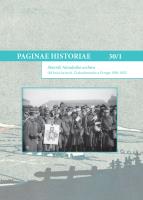Jihlava v období vyostřených národních a třídních rozporů let 1918–1922
Jihlava at the Time of Escalated National and Class Conflicts during 1918–1922
Author(s): Radim GondaSubject(s): History, Local History / Microhistory, Interwar Period (1920 - 1939)
Published by: Národní archiv
Keywords: urban history; national relations; Czech-German relations; social democracy; strikes
Summary/Abstract: Using the methodological tools of the cleavage theory and critical junctures presented by the Norwegian sociologist and political scientist Stein Rokkan, the text describes the fundamental conflicts and their structural and dynamic expression in the town of Jihlava with mixed nationalities during the constitution and stabilisation of the Czechoslovak Republic in the years 1918–1922. The Czech-German national cleavage produced two blocs of political parties with a slight German prevalence. The most escalated manifestation of the national cleavage dates from June 1920 with bloody acts of violence during the unpermitted procession to the city centre as part of the German celebration of the solstice. The work-capital cleavage gave rise to the strong Czech and German Social Democratic Party with more than 44–46% of the votes. The critical juncture of the international revolution led to a deep dissension inside the social democratic movement, absolute prevalence of leftist wings in the two national social democratic parties, their close collaboration, and eventually their joining to form the relevant communist party.
Journal: Paginae Historiae
- Issue Year: 30/2022
- Issue No: 1
- Page Range: 245-307
- Page Count: 63
- Language: Czech

